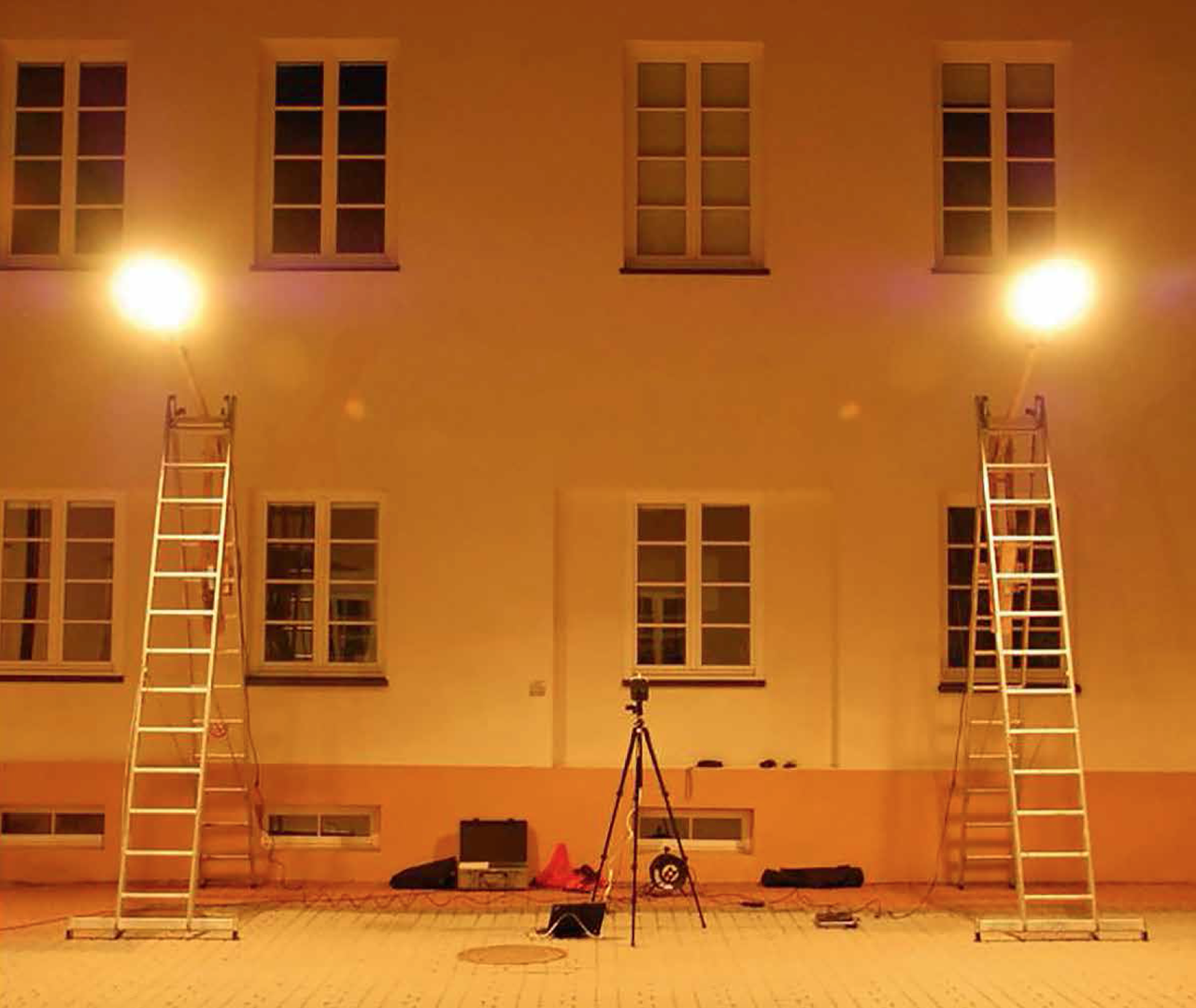Human-Focused Outdoor Illumination: Trade-Off Between Pleasing Color and Circadian Action, by the Vilnius University
A smart RGBA solid-state light engine with tunable correlated color temperature (CCT) and high-fidelity color rendition was applied for the validation of the Kruithof hypothesis in several outdoor environments. Subjects were asked to find the most “pleasing” illumination conditions by performing a CCT adjustment. Maintaining constant illuminance, the mean selected CCT was found to increase from about 3000±200 K at 5 lx to about 3500±250 K at 50 lx almost independently of the content of the viewed scene. Dr. Pranciškus Vitta, Head of Lighting and Electronics System Lab at the Vilnius University shows that this increase is statistically significant and provides qualitative validation of the Kruithof hypothesis in outdoor environments, but with the intervals of CCT for “pleasing” illumination, it is substantially broader and shifted to higher values.
The correlated color temperature (CCT) of a light source is defined as the temperature of an ideal black-body radiator that radiates light of the same hue as the light source under test. The light within the range of 2,500 to 10,000 K is usually treated as “white” with warm yellowish and cool bluish hues at the low and high ends of the CCT range, respectively. Until the era of solid-state lighting, the available colour temperatures were limited to a finite number of choices due to the technological limitations of incandescent, fluorescent and discharge lamp technology. In 1941 A. A. Kruithof, the researcher of Philips Labs, raised the hypothesis that humans prefer light of different CCT under certain conditions of illuminance [1].
Despite the incomplete experimental data, the key point of the Kruithof hypothesis is the existence of the regions of illuminance levels and colour temperatures that are perceived by an observer as “pleasing” (Figure 1). According to this work the “pleasing” lighting conditions are achieved within the narrow area between the red and blue curves in figure 1, while the upper and lower areas are perceived as unpleasantly yellowish and bluish, respectively.
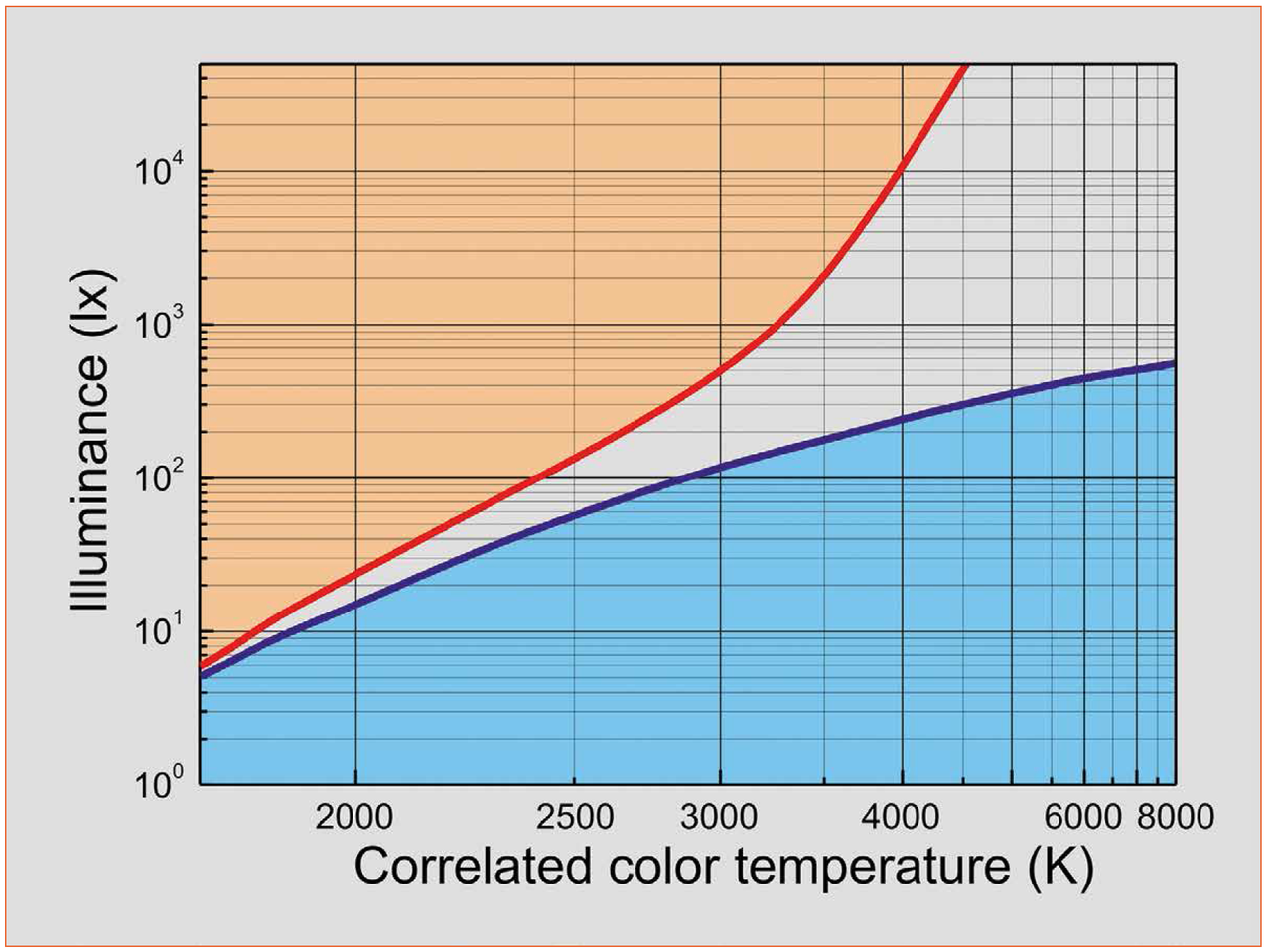
Figure 1: Kruithof hypothesis - the area between two curves is claimed to delineate the conditions for “pleasing” illumination
Plenty of studies were performed in order to confirm or deny the Kruithof predictions. Most of the studies were focused on indoor office or household illumination conditions with illuminances ranging from 100 to 1000 lx. Some researchers performed studies with a large number of subjects and claimed to confirm the hypothesis qualitatively by finding the trend of increased CCT with increasing illuminance. Moreover, the subjective ranking of fluorescent lamps has shown that the most “pleasing” CCT for office environments is around 4000 K, which agrees with the Kruithof. On the other hand, the other independent research groups have revealed the preference to higher illuminance irrespectively of CCT [2]. Such findings imply that the range of “pleasing” CCTs might exist for a constant illuminance, but for a constant CCT, the higher the illuminance the more “pleasing” conditions. Also, no effect of CCT on task performing and cognitive activity was found at the office illuminances of 300-600 lx, but the influence of the CCT on mood was observed.
For outdoor environments, practically no scientific evidence exists to support the Kruithof predictions because of the very narrow intervals of “pleasing” CCTs proposed for low illuminances. For the illuminance recommended by the European standard on road lighting (2-50 lx), the Kruithof implies the most “pleasing” CCTs to be below 2500 K. Occasionally, the high-pressure sodium (HPS) lamp technology, which was introduced several decades after the Kruithof work, became the most popular outdoor light source. HPS lamps deserved this success due to significantly high luminous efficacy (80-140 lm/W), relatively small size, long lifetime and color rendering properties better than those of low pressure sodium ancestors. Later, when new technologies started breaking into the outdoor lighting market, HPS lamps were considered as reference light sources to compare with and evaluate the new ones. Despite the success story of HPS lamps, scientists still try to find the most appropriate CCT for illuminance conditions typical of outdoor environments. Again, subjective feelings such as comfort and safety in parking lot environment were shown to increase with increasing illuminance for both HPS and metal halide (MH) types of lamps (2000 K and 4250 K, respectively) with no effect of the CCT [3]. On the other hand, some other studies showed that subjects prefer LEDs or MH lamps of warm white and cool white colors (ca. 3000-4000 K) in respect to HPS (1900 K); however the effects of color rendering and CCT on subject decision making have been not distinguished.
In addition to the visual satisfaction effects described above, short-wavelength light has non-visual (photobiological) effects on humans and other living beings, especially at nighttime. Therefore the switching from blue-deficient light sources to blue-enriched ones is actively debated. [4] In particular, with the discovery of intrinsically photosensitive retinal ganglion cells, which contain blue-light absorbing melanopsin photopigment, the application of blue-enriched light (MH lamps and common LEDs) in night-time environments is recognized to be harmful due to the suppression of pineal melatonin secretion and the shift of melatonin time-phase even at low illuminances [5]. Melatonin is recognized as one of the main oncostatic hormones in human body also responsible for the circadian rhythms. Therefore addressing the melatonin suppression ability of light while selecting “pleasing” CCT in outdoor environments is also important.
Below we demonstrate the variation of the subjectively selected “pleasing” CCT with illuminance for different outdoor environments. Also is shown the readiness of subjects to sacrifice pleasantness when the selection of CCT is subjected to dimming in order to maintain constant circadian irradiance.
Experiment
Keeping in mind both subjective visual comfort and photobiological action, the Lighting Research Group of Vilnius University performed an experiment with a tunable multicolor LED based light engine. Custom design outdoor luminaires consisting of four color high power LEDs (red, amber, green, and royal blue) and wirelessly controlled 4 channel power supplies were employed for the smooth adjustment of the CCT of light [5]. The image of the experimental scene is presented in figure 2 where the luminaires are mounted on 4.2 m high ladders (the experimental equipment can be also seen). The control algorithm inside the remote computer was able to instantaneously maintain the high color fidelity regime (Ra >91) in the entire CCT adjustment range by running the color-mixing optimization routine for the four primaries. Subjects were allowed to synchronously control the two luminaires via a smart phone graphical interface with unscaled slider by selecting the desired CCT within 1850-10000 K linear range using the forth and back adjustment in 10 K increments. The examples of light spectra for different CCTs are depicted in figure 2a. Also, the software allowed for operating the illumination conditions in two experiment modes. In the first mode, the constant illuminance (photopic 5 x and 50 lx, which correspond to EN 13201 standard road classes S4 and CE0, respectively) was maintained by the luminaires while adjusting the CCT and this regime was employed to validate the genuine Kruithof hypothesis. In the second mode, the software limited the circadian action of the illuminance by dimming the luminaires when blue rich (higher CCT) lighting was selected. The 5 lx and 50 lx illuminations by HPS lamp (1900 K) were used as circadian action irradiance reference points measured in arbitrary units and equivalent to “5 arb. u.” and “50 arb. u.”, respectively. The circadian action was calculated as an integral of the spectral power distribution of light weighted by the circadian efficiency function [6]. The dashed lines in figure 3a show the spectra of the light engines in the constant irradiance mode, while the dependence of the dimming factor on CCT is depicted in figure 3b. After adaptation to certain illuminance level, each of the respondents was asked to make four selections of the most “pleasing” CCT under two constant illuminance and two constant circadian irradiance conditions.
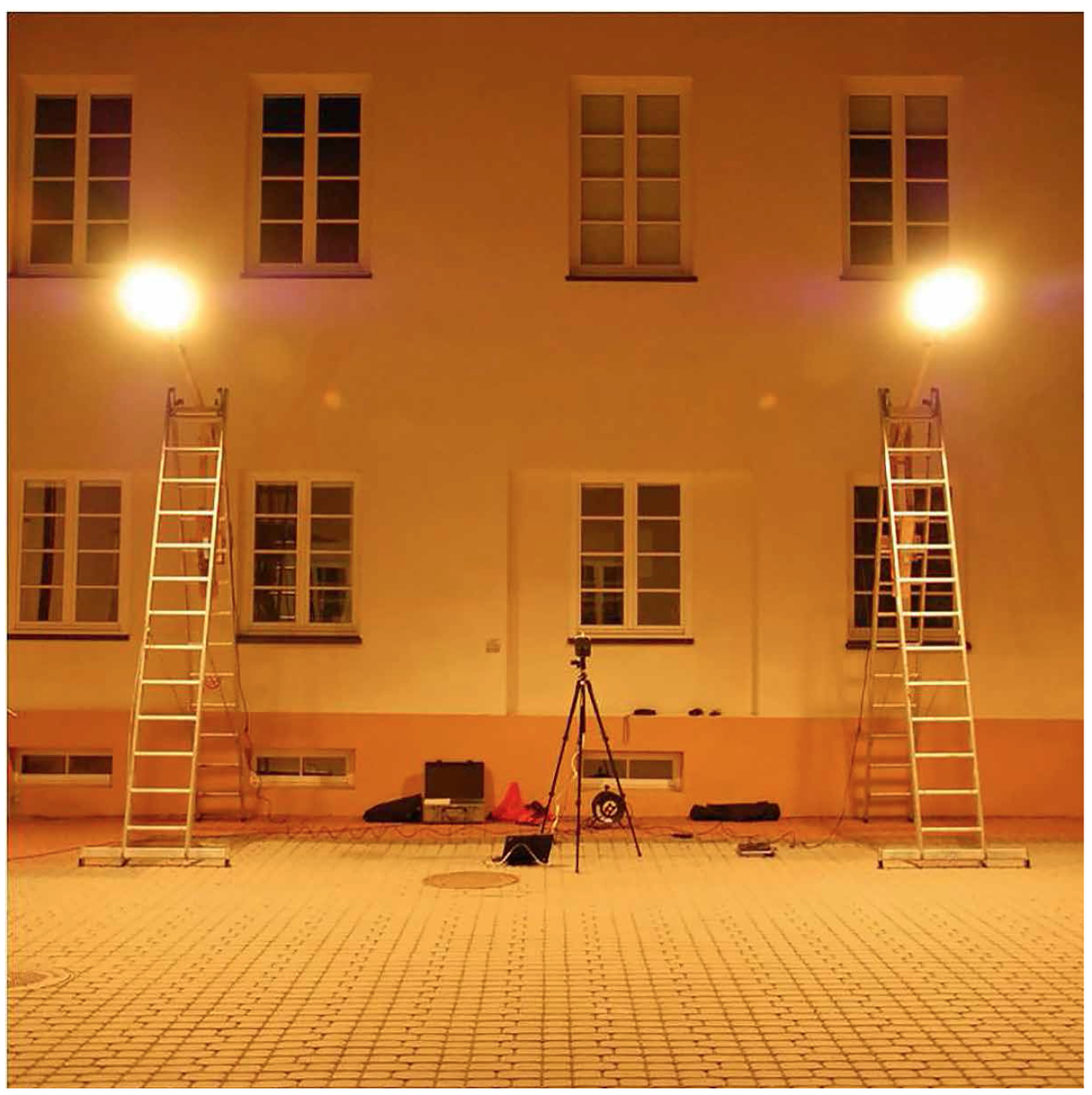
Figure 2: Experimental environment within Bursy courtyard of Vilnius University
The experiments were performed within three environments in Vilnius city. The main experiment was arranged in the Bursų courtyard of the historical campus of Vilnius University. The gray pavement, yellowish and reddish walls and single green tree were the dominating objects of the field of subject’s view. The supplementary experiments were carried out in the park area (Botanical Garden of Vilnius University) and in the area of modern city (near Lithuanian National Gallery of Art) with the dominating green and brown, and grayish color hues, respectively. The supplementary experiments were carried out to check whether different surroundings could have an influence for the selection of the most “pleasing” color temperature of illumination. 40 respondents took part in the main experiment while 22 and 27 subjects participated in the supplementary experiments, respectively. The subjects were mostly Vilnius University students and staff of age ranging from 19 to 57 (in average 24) with 43% of females and 57% of males.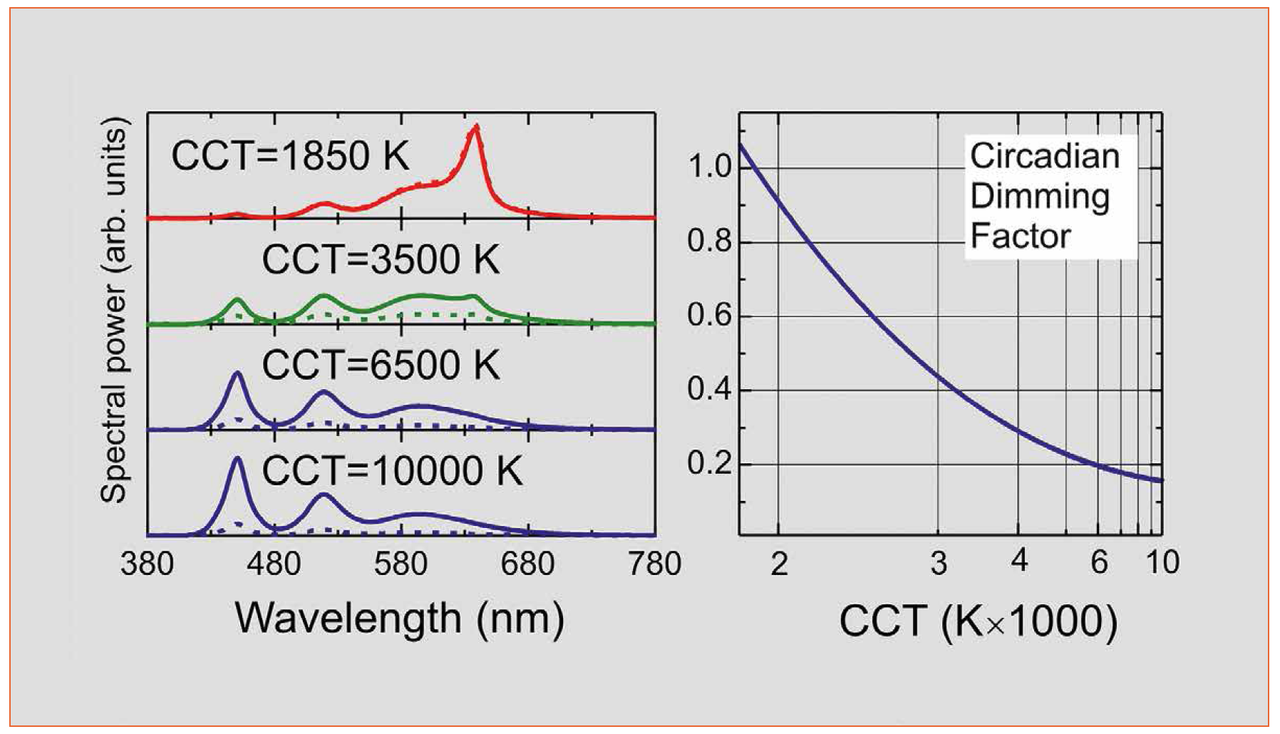
Figure 3: Spectral power distributions of the tunable light source for different CCTs in the constant illuminance (solid lines) and constant circadian irradiance (dashed lines) regimes (left). Dependence of circadian dimming factor on CCT (right)
Results and Discussion
The summarized results of the research are depicted in figure 4. The colored solid bars show the obtained mean values of the “most pleasing” CCT for each of the four conditions and three environments with the confidence intervals depicted as error bars. Wide confidence intervals evidence the large scatter of the individual judgment results. Despite large scattering, a characteristic shift from about 3000 K to about 3500 K can be seen with increasing illuminance from 5 lx to 50 lx under constant illumination conditions. These values correspond to “warm white” range of white light and are significantly higher than those predicted by Kruithof (gray horizontal lines in Figure 4). Interestingly that in earlier experiments with fixed number of light sources [3], this range of CCT was missed and no difference in preference was found between HPS and “cool white” MH lamps. Qualitatively similar trend (increase from 2500 K to 3200 K) can be noticed for constant circadian irradiance conditions when changing from 5 arb. u. to 50 arb. u. On the other hand, the CCT selection difference when changing from constant illuminance to constant circadian irradiance regimes depends on the illumination level. At low circadian irradiance (5 arb. u.) subjects preferred to have more light at noticeably lower CCT of about 2500 K in comparison with that in the constant illuminance regime (about 3000 K). In this case, the illuminance dimming factor had a moderate value of 0.6. At higher circadian irradiance (50 arb. u.), the mean selection was about 3200 K, which does not significantly differ from that in the constant illuminance regime (3500 K). However, in this case they complied with a much lower illuminance (dimming factor of 0.4).
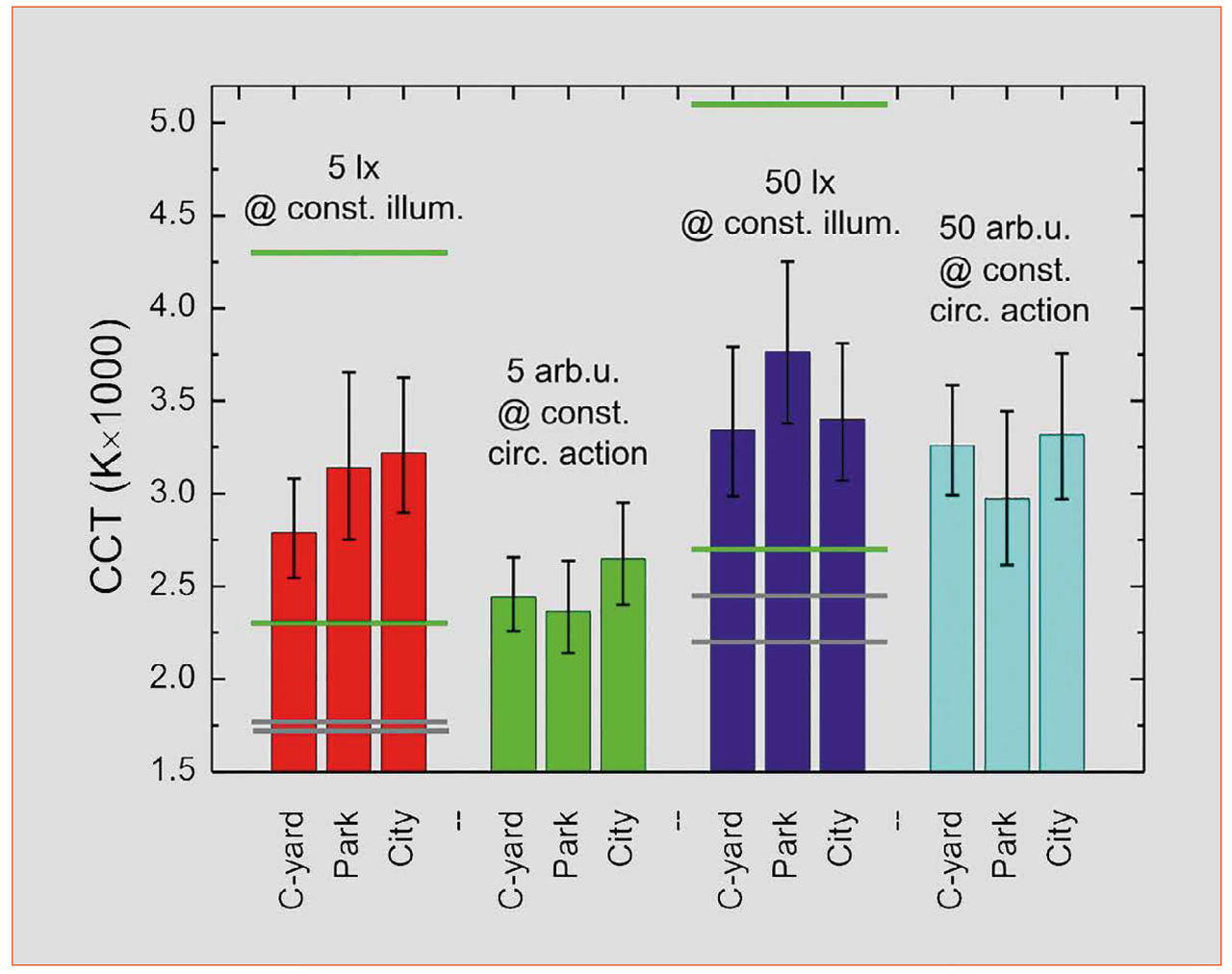
Figure 4: Solid bars are mean values of the most “pleasing” CCT in three environments and four experimental conditions. The iIntervals of pleasing conditions proposed by Kruithof and current study are between the gray and green lines, respectively
Our results qualitatively validate the Kruithof effect in outdoor environments by that with increasing the illuminance the higher CCTs are considered as “pleasing.” Furthermore the “pleasing” intervals of CCT, which can be delineated by the standard deviation of the data, seem to be much wider than the intervals defined by Kruithof at low illuminance (Figure 1 and Figure 3). In particular we can claim that the intervals of the “pleasing” CCT do exist for certain illuminance conditions and are in average the most acceptable by the subjects in terms of pleasantness without a particular task. Complementary experiments with dimming that avoid the increase of circadian disruption showed that at low illuminance levels the illuminance is more important for subjects than the preferred CCT. Meanwhile, at higher illuminance levels, subjects tended to sacrifice some illuminance for the sake of the preferred CCT. It is worth noting that the described research results are limited to a single geographical latitude (55°N) and single cultural background of the respondents.
Conclusions
The intervals of CCT corresponding to subjectively “pleasing” illumination conditions were established for illuminances typical of outdoor environment. By performing a CCT adjustment task under constant illuminance provided by continuously tunable solid-state light engine with high-fidelity color rendition, the Kruithof hypothesis was qualitatively validated by that the subjectively selected “pleasing” CCT shifts to higher values when illuminance level is increased. However the preferred CCT was found to have much higher mean values and much wider intervals than those predicted by Kruithof. The values obtained do not significantly depend on the content and color gamut of the scene at least for a particular cultural group of subjects and geographic latitude.
In addition the constant circadian irradiation experiments showed that at lower levels of illuminance subjects tended to select CCT that is lower than “pleasing” in order to obtain higher illuminance. On the other hand, at higher levels of illuminance subjects complied with more noticeable dimming for the sake of maintaining “pleasing” CCT.
Acknowledgements:
The current research was performed by the staff and students of the Lighting Research Group of Vilnius University (Lithuania) with the technical support of Ledigma Ltd. (Vilnius, Lithuania) and financial support by the Lithuanian Research Council (grant number ATE01/2012).
References:
[1] Kruithof AA: Tabular luminescence lamps for general illumination. Philips Techn Rev 1941, 6:75-73
[2] Wake T, Kikuchi T, Takeichi K, Kasama M, Kamisasa H: The effects of illuminance, color temperature and color rendering index of light sources upon comfortable visual environments in the case of office. J Lighting Vis Env 1977, 1:31-39
[3] Boyce PR, Bruno LD: An evaluation of high pressure sodium and metal halide light sources for parking lot lighting. J Illum Eng Soc 1999, 28:16-32
[4] Int. Dark-Sky Assoc. Visibility, environmental, and astronomical issues associated with blue-rich white outdoor lighting, IDA, Washington, DC, USA, 2010
[5] S. W. Lockley, G. C. Brainard, and C. A. Czeisler, High sensitivity of the human circadian melatonin rhythm to resetting by short wavelength light, J. Clin. Endocr. Metab., vol. 88, no. 9, pp. 4502-4505, Sep. 2003
[6] Žukauskas A, Vaicekauskas R, Vitta P, Tuzikas A, Petrulis A, Shur M: Color rendition engine. Opt Express 2012, 20:5356-5367
[7] Gall D: Circadiane Lichtgrößen und deren messtechnische Ermittlung. Licht 2002, 54:1292-1297
